Last week in RES Hub, UTS Faculty of Health hosted the UTS 2025 Collaboration Scheme Launch and shared insights from 2025 grant recipients about their experiences and projects.
UTS 2026 Collaboration Scheme Launch
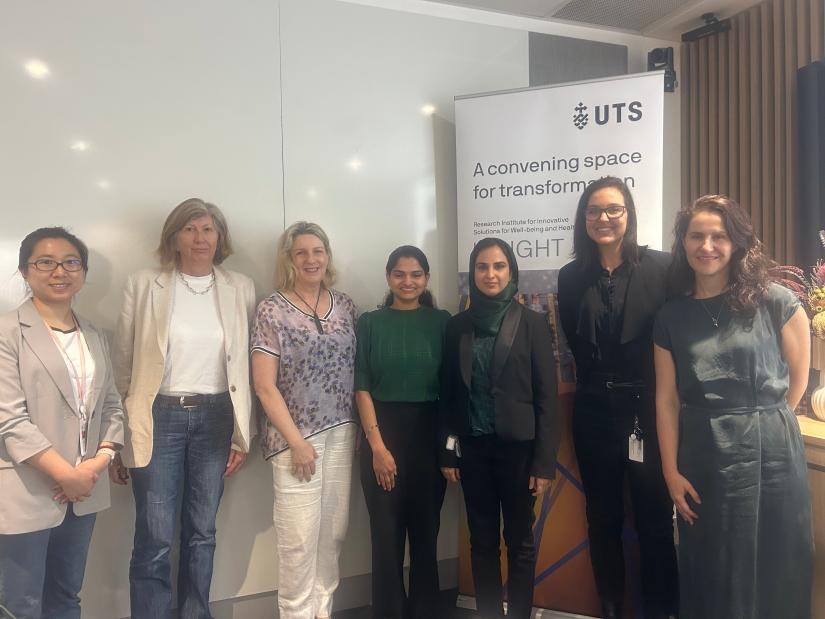
Caption
From left to right: Dr Yufei Zhao, Dr Theresa Harada, Prof Susan Morton, Dr Meera Radhakrishnan, Dr Jia Khan, Dr Frederique N. Sunstrum and Dr Zoe Sadokierski
Robotics in healthcare
Dr Theresa Harada from Change for Good at UTS presented her cross faculty project that links robotics and healthcare, “Human Robot Collaborations and Behaviour Change: Possibilities for improved outcomes in Health”.
Theresa developed this project with Jacqui Pitch, Prof Sally Inglis and Dr Jane Hutchens from the UTS School of Nursing and Midwifery and Prof Dikai Liu and PhD candidate Resul Dagdanov from the UTS School of Mechanical and Mechatronic Engineering.
Their project addresses the significant number of injuries in health care and nursing, especially from lifting.
“One of the solutions is to provide robotic lifting hoists to solve this problem and help nurses to avoid injuries,” Theresa said.
However, there is resistance to the uptake of robotic aids and intelligent robots. This may be due to distrust in robots or fear of robots replacing jobs, among other reasons.
One of the solutions is to provide robotic lifting hoists to solve this problem and help nurses to avoid injuries.
“We heard anecdotally from Jacqui Pitch that some established healthcare workers were very resistant to incorporating robotic devices into healthcare whereas new graduates generally had more experience with robotic healthcare and advocated for more uptake.”
To investigate further, the team set up a hospital scenario in a laboratory setting with a voice enabled robotic lifting device called SAM (Smart Aid for Mobility) that the nurses could interact with. The robot was able to speak in natural language and provide instructions to nurses about how to operate the lifting device.
Some student nurses were resistant to the robot and did not ask many questions. Others trusted their own ability over that of the robot or approached the task by asking many questions to master the use of the robot.
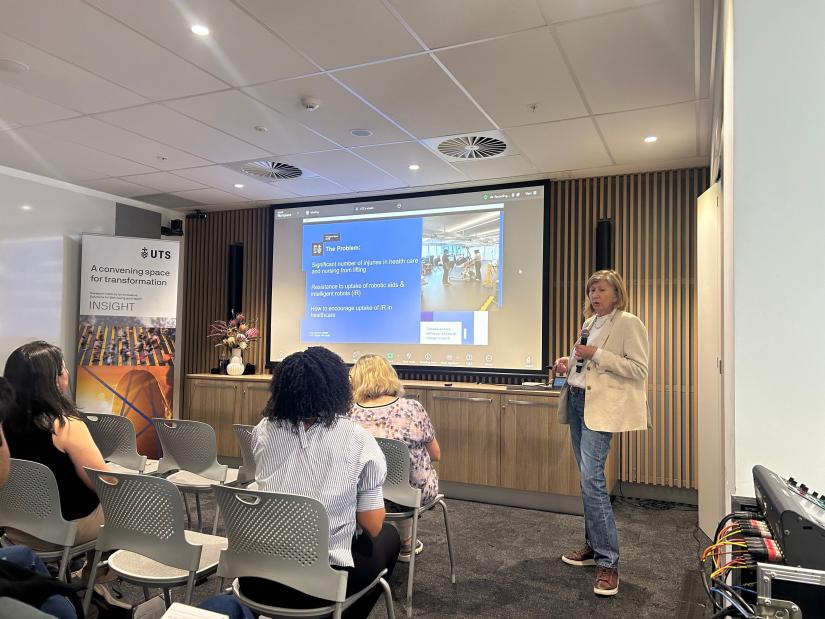
The team has completed the laboratory experiments and is now in the follow up interview and data analysis stage.
“We have been discussing the scenario of possibly enlarging our scope and doing another project to test out certain elements we have found,” Theresa said.
“We have the technology but not the uptake. Humans are not logical decision-makers and often do things against their best interest.”
Change for Good at UTS hopes to devise social and behavioural change programs that can lead to better outcomes in healthcare through understanding better the barriers to uptake of the technology, and how the technology can be better designed for maximum impact.
Converting biomass to renewable energy
Dr Yufei Zhao from the Faculty of Science discussed the project to convert biomass into a renewable energy source, “Biomass waste-derived electrocatalysts for hydrogen production.”
Yufei is working with Distinguished Professor Guoxiu Wang from the UTS Faculty of Science, Prof Yaowen Shan from UTS Business School, DECRA Fellow Dr Yuhan Huang from UTS Faculty of Engineering and IT and Chancellor's Research Fellow Dr Kumar Biswajit Debnath from UTS Faculty of Design and Society.
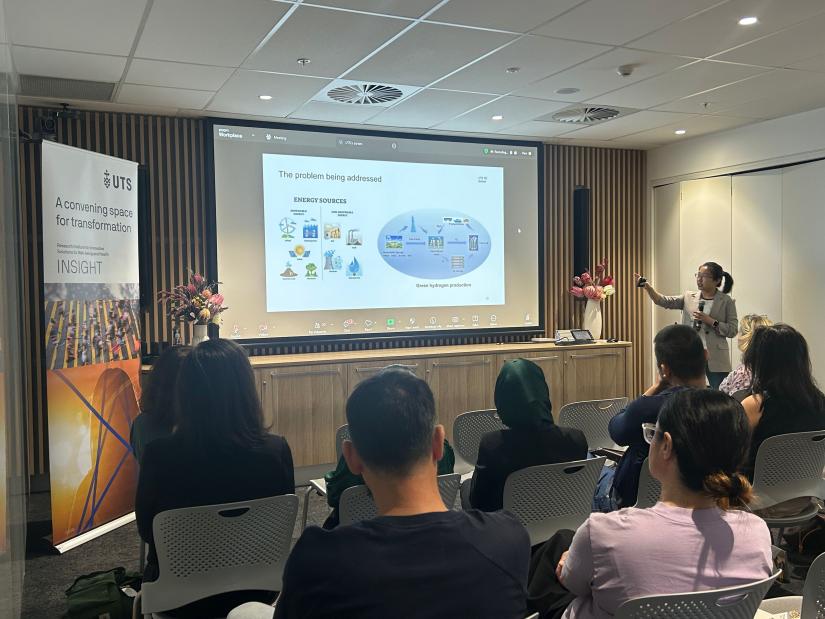
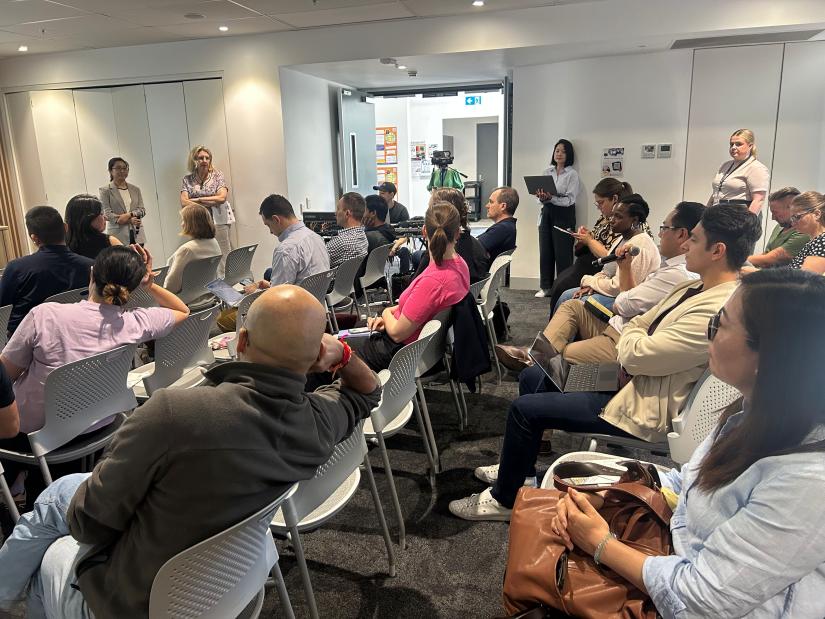
“What we are trying to do is utilise renewable energy sources for energy storage and conversion, to replace non-renewable energy” Yufei said.
“The problem with common sources of renewable energy such as wind, hydropower and solar are their intermittent properties.”
“We would like convert these renewable energy sources to chemical energy, creating green hydrogen, and be able to store the renewable energy for future use.”
The team’s research focus is on water-splitting and electrolysed water, a vital stage in the process of converting renewable to chemical energy, using biomass as precursors to prepare carbon supported electrocatalysts for highly efficient hydrogen production.
We would like convert these renewable energy sources to chemical energy, creating green hydrogen, and be able to store the renewable energy for future use.
“In Australia, there is strong support for green hydrogen. Projects through UTS and the Australian Research Council have different strategies to support its production,” Yufei said.
“Hopefully we can use more and more hydrogen to replace petrol and batteries in the future.”
Troubling scientific archives
Dr Zoe Sadokierski from the UTS School of Design spoke about her unique collaboration exploring ways to expand the way museums value scientific collections, “Beyond the Platypus Man: connecting multi-institutional museum collections through creative practice research”.
Zoe’s creative collaboration involves teams from the UTS Schools of Design and Communication, Jumbunna and partners from the Australian National University as well as independent museum researchers.
Zoe said it can be difficult to get funding for creative practice research. “It’s not always clear where it will fit or where it might go next. I got rejected twice before my application was successful for this scheme. I think it is important to persist.”
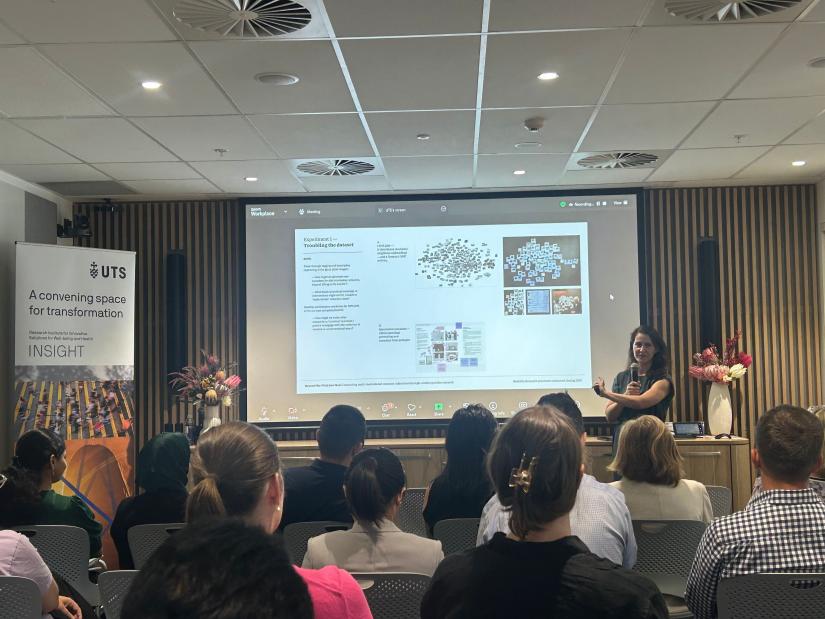
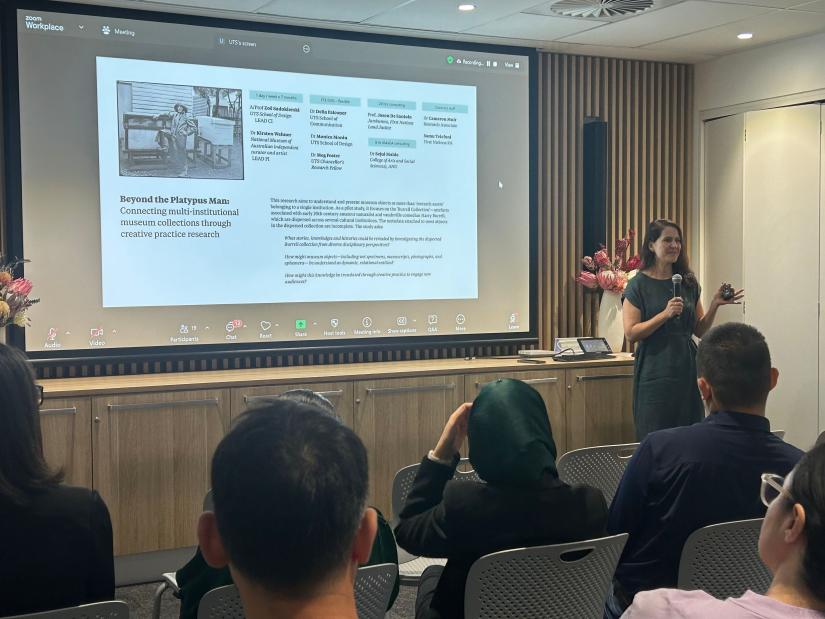
The team’s research focus is the Burrell Collection, a collection including monotreme (platypus and echidna) specimens collected by Australian amateur naturalist and vaudeville comedian Harry Burrell in the early 20th century. This collection is dispersed across at least five cultural institutions across Sydney, Canberra and Manilla, NSW.
“Our project is about how we might understand museum objects as more than research assets. What is a collection if it belongs to different institutions? What could you do with a collection that is incomplete?” she asked.
The Burrell Collection’s metadata is incomplete, Zoe said that we don’t know when or where many specimens were collected.
“As a science collection, it is not particularly useful anymore. But as a cultural or storytelling collection, it has lots of possibilities.”
Zoe discussed the creative practice element of the team’s research that includes taking photographs to imitate Harry Burrell’s photographs without using animals.
“How do you reimagine the naturalist tradition for the 21st century? What does it means to collect? To take something off Country?” Zoe asked.
As a science collection, it is not particularly useful anymore. But as a cultural or storytelling collection, it has lots of possibilities.
“There’s a range of performative activities we are doing, as a mode of thinking and opening conversations between each other. This isn’t the research output, it is part of our process to think creatively about how we might imagine these museum objects differently,” Zoe shared.
Zoe cautioned against telling people what to do and what their job will be in a project team when collaborating across disciplines. Instead, she recommends leaving enough space for people to come in and say ‘this is what I’m doing elsewhere, and this is where it can fit in your project.’
Cardiovascular Disease (CVD) monitoring using textiles
Dr Frederique N. Sunstrum presented her multi-functional research collaboration that explores the use of textiles for continuous CVD monitoring, “Textile-based Wearable Sensors for Continuous Healthcare Monitoring”.
The collaboration includes Dr Jawairia Khan and Dr Gungun Lin from the UTS Institute for Biomedical Materials and Devices in the UTS School of Mathematical and Physical Sciences, Prof David Sibbritt of the UTS School of Public Health, Roderick Walden, A/Prof Bert Jacobus Bongers and Dr Nga Wun LI from the Faculty of Design and Society, Dr Meera Radhakrishnan and Roupen Minassian from UTS Data Science Institute, and Dr Michael Behrens and Max McKay from UTS Rapido.
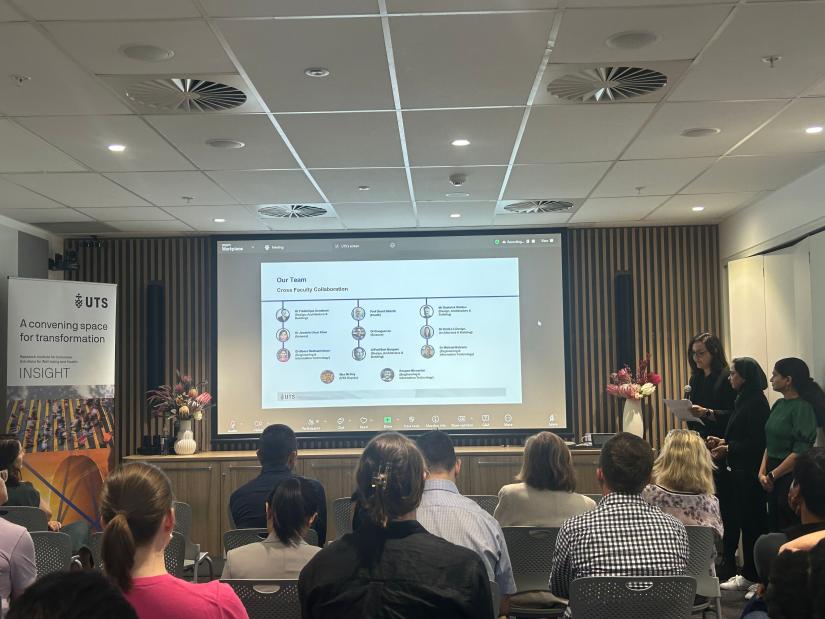
The team’s focus is on cardiovascular diseases (CVDs), the leading cause of death globally, accounting for 24% of Australian deaths alone, where stroke is one of Australia’s biggest health problems. With one in six Australians living with CVD,these diseases cost the Australian government 12.7 billion dollars a year.
Frederique shared that CVDs require continuous monitoring for early detection, prevention and management. Therefore, the team’s goal is to develop a multimodal wearable textile health-monitoring prototype.
“There are problems with existing … products like your smart watch, which will not pick up your heart rate efficiently nor effectively. There are also limitations in the placement,” she said.
“We have chosen textiles as a solution for optimal skin positioning, providing comfort and effective health monitoring. We want to enable precise, accurate and real time cardiovascular monitoring in a seamless integration,” Frederique said.
“We want to facilitate early-detection and management and also to enhance prevention through predictive insights, particularly with stroke survivors.”
We have chosen textiles as a solution for optimal skin positioning, providing comfort and effective health monitoring. We want to enable precise, accurate and real time cardiovascular monitoring in a seamless integration.
Frederique discussed the limits to current products on the market including that most have not passed the required approvals processes. This could be due to different environmental and physiological factors influencing the accuracy, limiting their sensitivity to picking up heart rate signals.
To address this challenge, the team’s solution uses nano-coated conductive yarn alongside a multimodal sensor integration to increase accuracy and sensor performance.
Apply for the UTS 2026 Collaboration Scheme
“There is a breadth of wonderful research that can be done using a reasonably small amount of money over less than a year,” said this Prof Susan Morton whose team is facilitating the 2026 Scheme administration. “It is remarkable to see preliminary results from these 2025 projects given the restricted budget and time frame.”
Requirements, eligibility and funding
- Applications must contain researches from 2 or more UTS faculties, with more than 2 being looked upon favourably.
- The Lead Chief Investigator (CI) cannot have been the Lead CI of a successful 2025 Collaboration Scheme application and cannot be the Lead CI on any current externally funded research project(s).
- As defined for the purposes of this scheme, the Lead CI cannot be the First Named Chief Investigator (FNCI) on a successful v1 (establish) My Proposal for any active externally funded research project as at the closing date of the 2026 Collaboration scheme.
- Funding is capped at $50,000 per application. Equipment items >$5K, conference travel, open access fees, and CI salary costs are not supported.
Criteria
- Strength of the proposed research project (30%)
- Feasibility of collaboration and likelihood of competitive grant application and/or publication/s or other outputs resulting from collaboration (25%)
- Value for money (25%)
- Focus on Research Translation and/or end-user engagement (20%)
Important dates
- Applications open in Research Master: 20 Oct 2025
- Applications close in Research Master: 3 Dec 2025 (5 PM)
- Anticipated announcement / project commencement: 3 Mar 2026
- Project funding spent: 30 Nov 2026
- Final Report Due: End of Mar 2027
Applications for the 2026 Scheme close 3 December.